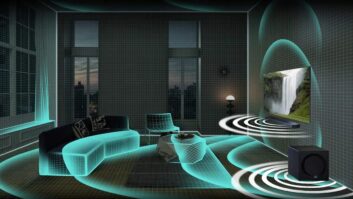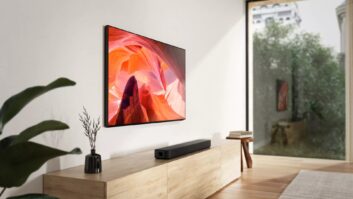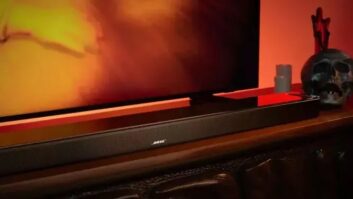
New York – Five new audio/video receivers unveiled by Pioneer include the company’s first three models with Dolby Atmos decoding, whose soundfields can be reproduced by the company’s first Atmos-enabled home-theater speaker system.
With the introductions, all in the Elite series, Pioneer is maintaining its Elite SKU count at seven but reducing its mainstream Pioneer AVR selection to four SKUs from seven to reduce overlap. The Pioneer line now tops out at an everyday $599 instead of $1,600, and the Elite series continues to run from $500 to $3,000.
Several years ago, the company expanded the Pioneer series to serve custom installers who did not meet business requirements for selling the Elite series. The company declined to say whether Elite and mainstream-Pioneer distribution will change now that the mainstream line has been narrowed.
In aftermarket car developments, the company launched an AppRadioLIVE app that runs on iPhones and connects to all current and previous-generation AppRadio and AppRadio Mode big-screen head units to integrate previously separate Internet-accessing iPhone apps into a single in-dash user interface to simplify operation. An Android version of the app is in development. Data integration is accomplished by a Pioneer cloud server instead of by the phone itself to reduce cellular-data consumption, the company said.
In home theater, Pioneer unveiled the $1,000-everyday SC-81 and $1,300 SC-82 AVRs for July availability and the $1,600 SC-85, $2,000 SC-87, and $3,000 SC-89 AVRs. The latter three ship in late August and “soon after” will get a firmware upgrade to add Dolby Atmos decoding.
To go with the Atmos AVRs, the company plans August availability of an Atmos-enabled 5.1 speaker system that delivers a 5.1.4-channel Atmos soundfield. The products include a $749-everyday bookshelf pair and a $699-each tower speaker. All incorporate a height driver on top, angled up, crossed over at a Dolby-specified frequency, and driven by its own amplifier channel to place individual sounds overhead sounds by reflecting them off a ceiling.
The speaker selection also includes a $399 center channel and a $599 10-inch subwoofer.
The three Atmos AVRs and Atmos speaker system will be the only Atmos products from Pioneer through its fiscal year ending next March.
The company’s current Elite and Pioneer AVRs can’t be firmware-upgraded to Atmos because their DSP processors don’t have the speed to handle Atmos decoding, said Chris Walker, product planning director for home electronics.
The three Atmos AVRs are 9-channel models that drive two or four in-room height drivers in the new Elite speakers or two or four in-ceiling speakers. The other two AVRs are seven-channel models.
The company hasn’t decided whether it will offer optional Atmos height drivers that can be added to the flat tops of select speakers currently in the Pioneer line, said Walker, nor has it decided whether to offer on-wall height speakers.
All five AVRs are the first in the Elite series to offer HDMI 2.0 and Roku-ready MHL/HDMI port.
Compared to their predecessors, the top three models are the industry’s first with 5.0- and 5.1-channel decoding of high-resolution FLAC and WAV files, which can be delivered over a home network or via USB port, Walker said.
Compared to their predecessors, the top three models also add higher speed DSP chips to decode Atmos streams, Double DSD (5.6MHz) streaming over a network, dual independent subwoofer EQ, and new multichannel-speaker calibration that calibrates Atmos height speakers.
The top model, like last year, comes with a single HDBaseT output to send HDMI video over a long cable to other rooms.
All five models use an HDMI 2.0 chip that delivers the 2.0 spec’s maximum 18Gbps data rate to offer such features as 4:4:4 color for 60fps 4K UHD video and, for the future, high-dynamic range capability, 32 audio channels, and other enhancements enabled by higher speeds, said Walker.
None of the AVRs features HDCP 2.2 copy protection, Walker said, because of price and timing. A single-chip solution combining HDMI 2.0 and HDCP 2.2 isn’t yet available, and a two-chip solution would be more expensive and prevent Pioneer from keeping the AVRs’ pricing flat with their predecessors’ pricing.
The SC-81 and SC-82 are the first AVRs in the industry that meet Energy Star 3.0 standards, the company noted.
Atmos, which has already been deployed in select movies and cinemas, places and moves individual sounds anywhere in a room, including overhead, Dolby has said. The technology creates a more life-like experience in which more individual sounds can be placed anywhere in a 360-degree space, Dolby previously said. Sounds also pan more smoothly around you, and the surround experience is improved no matter where you sit.
With Atmos, sound studios attach specific X, Y, and Z coordinates to each sound to describe that sound’s location in three-dimensional space at any given time. That frees movie studios from the limitations imposed by cramming many sounds into a limited number of discrete channels.













